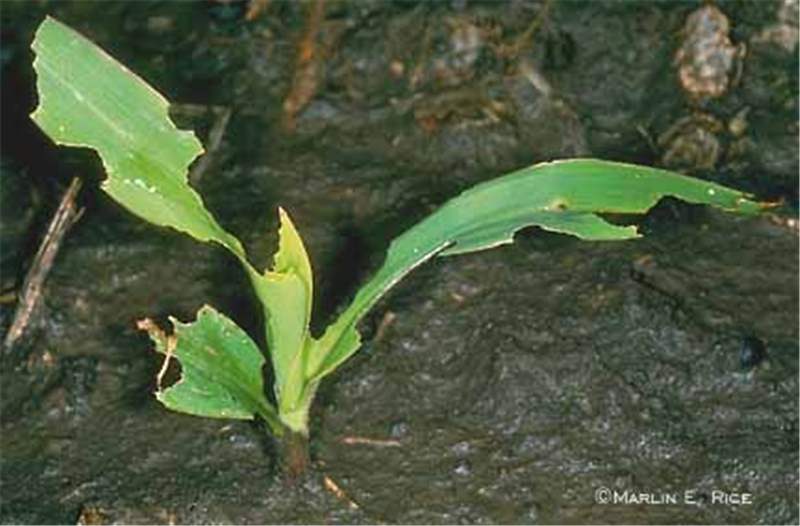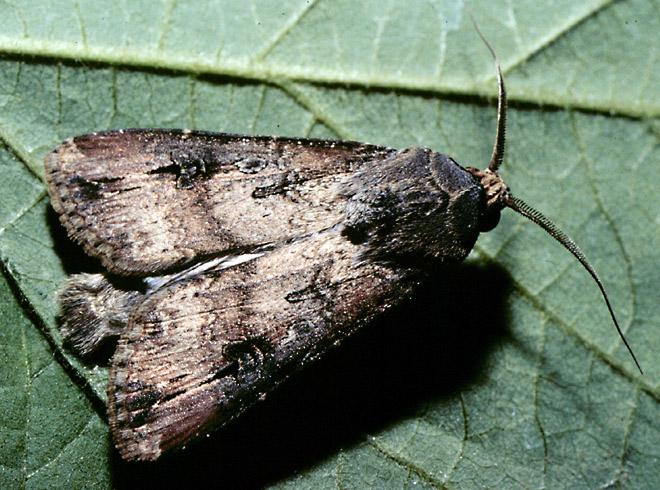Black Cutworm
Agrotis ipsilon
|
Full grown black cutworm larva (J. Smith). |
Adult black cutworm. |
 Cutworm damage. Cutworm damage. |
Black cutworm moths are strongly migratory, breeding year-round in southern latitudes and arriving in Kansas in March. Females can each lay over 1,000 eggs, and there can be two or three generations per year. The host range is very broad, but corn is usually damaged within the first two weeks after planting. Larvae hide in the soil and emerge to feed at night. Feeding damage by small larvae is inconspicuous; notches chewed out of leaf edges or transparent 'windows' caused by removal of a single layer of cells from one side of the leaf. Larger larvae can sever small plants at the base or kill the growing point within the whorl. Significant stand reductions can result if larvae are abundant. Preplant or planting-time treatments for cutworms are only justified in situations where problems are severe year after year. Although seed treatments containing thiamethoxam or imidicloprid will provide some protection of seedling plants, rescue treatments (applied postemergence) are almost always preferred over preventive treatments applied at or before planting. Larvae have a diverse assemblage of microbes in their gut, some of which have been implicated in accelerating the degradation of some common insecticides, thus contributing to increased resistance. There is evidence that some black cutworm populations are evolving tolerance to chlorantraniliprole and related diamide insecticides. Corn hybrids with the Herculex I Insect Protection are resistant to black cutworm damage.
Cutworm problems may occur statewide, but serious damage is more common in eastern Kansas, although problems are less frequent than in corn production areas to the east, which likely reflects the moth's migratory corridor. Cutworm problems are often associated with early spring weed cover prior to planting, which may attract egg-laying females. It can also be associated with late wet springs, permanent adjacent vegetation, rotations in which corn follows soybeans, and reduced tillage. However, cutworm problems are impossible to predict and often nonexistent, which is why rescue treatments rather than preventive treatments are recommended.
Cutworm-susceptible fields should be scouted frequently for damage from the start of plant emergence until the corn is 6 to 8 inches high. An insecticide treatment may be justified if 3 to 5 percent of plants in the two-leaf stage are being cut, and only if the majority of the worms are ½ inch or less in length. Each cutworm has the potential to cut from four to six plants at the two-leaf stage. Action should be taken at lower levels of stand loss at earlier stages of plant development, and under cool conditions that delay the growth of larvae. Conversely, larger plants growing under warm conditions will suffer less damage per cutworm. It is difficult to control cutworms once they reach ¾ to 1 inch in length, and larvae of this size will soon cease feeding and pupate. One alternative to treatment is to wait at least two weeks for worms to complete development and then replant where necessary.
Please refer to the most recent version of the Corn Insect Management Guide for treatment options.
Page last updated 3/28/2024 by J.P. Michaud.

